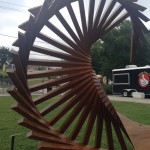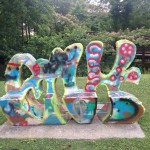“Love seeks to close all distance.”
— John Berger — And Our Faces, My Heart, As Brief As Photos
Life has a certain centrifugal force. In both large and small ways we are thrown to the edges, away from one another. The companion force is one that draws us to one another, that compels us toward together. The first force is a reality; the second, a choice. I live in a town where people — many people — make that choice on a daily basis, looking for ways to connect, for new eyes with which to see ourselves in new ways. Durham is the most encouraging place I have ever lived.
One of the most recent labors of love is the Bull City Sculpture Show, which was put together by the artists who make up Liberty Arts and who describe themselves as . . .
a nonprofit arts community whose collaborative practice reflects the dynamic personality of Durham, North Carolina. Our mission is to expand access to three-dimensional art and share the skills required to make it. All are welcome to take part through hands-on classes, public events, mentorships, and commissions. Liberty Arts believes in community outreach and encourages visionary thinking.
Part of their vision was to create space for sculptors to give us some new things to look at in and around downtown and, by doing so, give us new eyes with which to see ourselves and our city. They ran a successful Kickstarter campaign to raise enough money to offer artist grants and to build the necessary platforms and now there are twelve sculptures scattered across the downtown area, which means they are all in walking distance of our house.
Twice now — once with Ginger and once with my friend, Leon — I have walked around town to take in the sculptures. I won’t feign to be an art critic or even say I know that much about sculpture, and I was moved by what I saw on the streets where I live. On both sojourns I learned some things, saw things in new ways. I offer things I learned from the Bull City Sculpture Show — in no particular order.
Looking at things you don’t completely understand is expansive. Seeing the sculptures did more than make my mind work; I felt a physical change as well, as though my lungs expanded. I could breathe deeper. I know it sounds dramatic, and it’s what happened. The pieces of metal and wood that swirled and reached and clung to each other stretched me and invited me to rest and ruminate rather than rush on by. The specific offerings of the artists made my world larger.
Context matters. As we walked around town, I could see the folks who put the show together had worked hard to think

about where each piece should be placed. In some cases, the theme of the piece was tied to its location. In others, the shape of the space seemed to have been taken into account. Even so, some of the pieces were enhanced by their placements and some were diminished. Where we are makes a difference. My favorite piece in the show is my favorite in part because of where it was. “Pursuit of Happiness” is a wooden sculpture of a man carrying a box that is shaped like a bird house. He is made out of white wood and is wearing a hat. He is in a stand of trees next to the Carolina Theater, so he looks as though he is coming out of the forest, as though he is in motion, even though he is standing still. The “forest” made me wonder if he were homeless in his pursuit, or if he could be a fairy tale character. Had he not been in the trees I would not have seen him in the same way.
Things look different when seen from different perspectives. All of the sculptures in the show were placed so that we could walk around them and see them from all sides. Most of them changed as my perspective changed. “Winding Out”

looked like a turbine or a helix or a carnival slide depending on where I was standing. Saturday at the Farmer’s Market, I looked over to see a parent who had spread a blanket under the sculpture for her baby to get out of the sun and the spiral became a shade tree. There’s more than one way to look at most everything.
To be attentive is to see everything with new eyes. Most of the time we see what we are looking for. If we go looking for the same old things, we often find them. If we go looking for adventure, we find that, too. “Amuk” is a concrete bench made to be used. When Leon and I sat down, I looked across at the empty Farmer’s Market pavilion and saw the lines and angles as if it were a sculpture. As we walked through town, everything around me turned into art. I had never looked at the buildings that way. I’m not sure those intent on building edifices had art in mind in the same way as the sculptors intent on building community, but the art bled through nonetheless. The more we looked and talked and walked, all of us — Ginger, Leon, Durham, me — became part of the art show, part of the connectedness.

In some sense, I suppose, the lessons I learned are an exercise in stating the obvious. Then again, a day never goes by without Ginger and I telling each other, “I love you,” which is stating the obvious as well. When it comes to closing the distances between us, stating the obvious becomes a crucial act. We need to say again and again that we are all in this together. We need to remind one another to expect to find wonder and adventure as we go through our daily routines. We need to say out loud and over and over that there is work to be done to make sure everyone knows they belong.
And that’s what I learned at the sculpture show.
Peace,
Milton
I love this, Milton. A combination of several things so meaningful to me: connection, expression, place, community, visual arts, and thoughts on the ways we inhabit the space around us. Your post makes me want to go out and sculpt something! And kudos to Liberty Arts on the good work.
Thanks for sharing this, Milton. I love, not only your perspective on things, but also how you put words to them. I am taking with me a quotation from you, “We need to remind one another to expect to find wonder and adventure as we go through our daily routines.” That childlike state of imagination and joy is what keeps us alive in spirit and soul even when life may be beating us down. You always inspire me, Milton. Thanks, again, for continually sharing your heart.
I want to come over and take a walk too.
Good one Milton. I agree with what you said, “When it comes to closing the distances between us, stating the obvious becomes a crucial act.” We need to become more intentional, it is hard work but I think it makes things better in the long run.